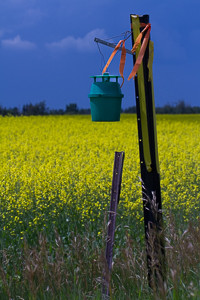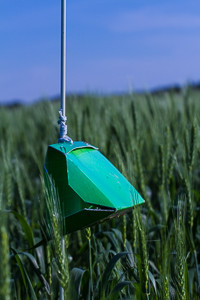Overview
Quality assurance, market access and yield are key to the success of Alberta’s agriculture industry. Surveillance and monitoring for insects provides a key piece to this success by gathering information about established species populations and new invasive threats to the cropping industry. This information can play an important piece in support of pest related trade discussions.
This work helps us to understand insect populations and range expansion of the targeted insects so that industry can understand the risk and potential damage. The information gathered from pheromone traps, field insect collections and counts or damage assessment is used to create forecast maps and make control recommendations. The data from the surveys is used for more than just creating forecast maps though, it can be used to direct insect pest research priorities or researchers can use the collection of samples in their studies.
The Alberta Insect Pest Monitoring Network coordinates, manages and carries out 7 insect surveys provincewide in Alberta’s field crops to assess presence, abundance and impact to the agriculture industry. The Network also conducts smaller targeted surveys on new and emerging pests working with Universities, Agriculture and Agri-Food Canada and Canadian Food Inspection Agency.
The success of the network depends on its dedicated partners that assist with surveillance, including:
- Agriculture fieldmen
- agronomists
- producers
- Plant and Bee Health Surveillance Section, Alberta Agriculture and Irrigation
Field surveillance program
Images. (left to right) Bertha armyworm, diamondback moth and wheat midge traps



Each year surveyors set out to count, sweep net and soil sample to gather information for insect survey and population maps in Alberta.
Producers can sign up to participate in the annual surveys by signing up to allow access to their land. Every year surveyors are looking for pea fields in the spring to access damage for pea leaf weevil, and in the fall, after harvest, wheat fields as they sample soil for wheat midge or count cut wheat stems in the case of wheat stem sawfly. Producers can help by contacting us and giving permission to visit their fields.
We understand that entering a field comes with responsibilities. Surveyors respect that the integrity and biosecurity of each field is of very high importance. Surveyors wear boot covers when entering fields, and park on the approach to the field or road side. All technicians and staff working for the entomology program are required to adhere strictly to this Field entry protocol.
View survey results
Table 1. Live feed map and annual survey results.
How to get involved
Help us build a robust pest-monitoring system in Alberta:
- monitor for bertha armyworm, diamondback moth, cutworm or cabbage seedpod weevil in your fields
- volunteer a pea field
- volunteer a wheat field
Sign up for annual survey
Get involved with the annual insect count by signing up to allow surveyors access to your land. Producers who participate help build population maps of pest insects. They also receive the results of the fields visited. To sign up, contact us.
Report scouting results
Crop consultants and farmers can fill out the online submission forms below to report location and other details about suspected finds:
Capture and contact
Table 2. Information resources for identifying crop and ornamental invasive species.
| Crop invasive species | Ornamental invasive species |
|---|---|
| Priority invasive and migratory insects to report – Prairie Region. It includes a link to report on iNaturalist. | |
| Swede Midge – if you find damage to canola plants that looks like Swede midge, contact us. | Asian Longhorned Beetle |
| Bronzed Blossom Pollen Beetle | Emerald Ash Borer |
| Brown Marmorated Stink Bug | Elm Bark Beetle (Dutch Elm Disease) |
| Japanese Beetle | Redneck Long-horned Beetle |
| Lesser Grain Borer | Spotted Lantern Fly |
| Western Bean Cutworm | Lymantria dispar dispar (LDD moth) |
If you see or find any of these invasive insects, capture them in a container and freeze. Record the date and location (GPS coordinates are ideal) where insect was collected. Then contact us.
Resources
Partner websites
Instructional videos
- Building a Bertha Armyworm Trap
- Building a Diamondback Moth Trap
- Building a Wheat Midge Trap
- Field Scouting for Bertha Armyworm
- Identifying and Scouting Wheat Midge in Alberta
- Proper Sweepnet Technique for the Cabbage Seedpod Weevil
- Sweeping Canola for Lygus Bugs
Contact
Connect with program staff:
Email: amanda.jorgensen@gov.ab.ca
Email: bugs.r.us@gov.ab.ca